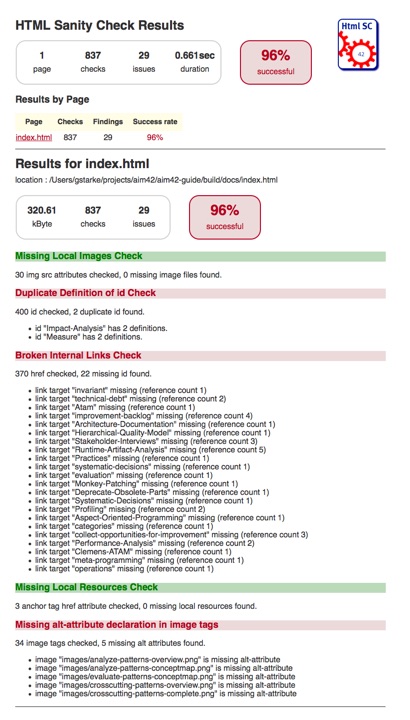
HTML Sanity Checker Architecture Documentation
© This document uses material from the arc42 architecture template, freely available at http://github.com/arc42. This material is open source and provided under the Creative Commons Sharealike 4.0 license. It comes without any guarantee. Use on your own risk. arc42 and its structure by Dr. Peter Hruschka and Dr. Gernot Starke. Asciidoc version initiated by Markus Schärtel and Jürgen Krey, completed and maintained by Ralf Müller and Gernot Starke. |
Version {version} of 2018-11-15
|
Within the following text, the "Html Sanity Checker" shall be abbreviated with HtmlSC |
Goals of this Documentation
This documentation is an example of arc42 documentation.
You may copy this documentation or parts of it for your own projects. In such cases you must include a link or reference to arc42 or aim42 (we regard this as fair-use).
For real-world projects, the relation of code and documentation is over-sized.
1. Introduction and Goals
HtmlSC shall support authors creating digital formats with hyperlinks and integration of images and similar resources.
1.1. Requirements Overview
The overall goal of HtmlSC is to create neat and clear reports, showing errors within HTML files - as shown in the adjoining figure. |
1.1.1. Basic Usage
-
A user configures the location (directory and filename) of one or more HTML file(s),
-
and the corresponding images directory.
-
HtmlSC performs various checks on the HTML and
-
reports its results either on the console or as HTML report.
HtmlSC can run from the command line or as Gradle-plugin.
Terminology: What Can Go Wrong in HTML Files?
Apart from purely syntactical errors, many things can go wrong in html, especially with respect to hyperlinks, anchors and id’s - as those are often manually maintained.
Primary sources of problems are bad links (in technical terms: URIs). For further information, see the background information on URIs.
See DuplicateIdChecker.
Checking and reporting these errors and flaws is the central business requirement of HtmlSC.
Important terms (domain terms) of html sanity checking is documented in a (small) domain model.
1.1.2. General Functionality
| ID | Functionality | Description |
|---|---|---|
G-1 |
read HTML file |
HtmlSC shall read a single (configurable) HTML file |
G-2 |
Gradle-plugin |
HtmlSC can be run as Gradle-plugin. |
G-3 |
command line usage |
HtmlSC can be called from the command line with arguments and options |
G-4 |
configurable output |
output can be configured to console or file |
G-5 |
free and open source |
all required dependencies shall be compliant to the CC-SA-4 licence. |
G-6 |
available via public repositories |
like bintray or jcenter. |
G-7 |
configurable to check multiple HTML files |
configure a set of files to be processes in a single run and produce a joint report. (useful for e.g. API documentation with many HTML files referencing each other) |
1.1.3. Types of Sanity Checks
| ID | Check | Description |
|---|---|---|
R-1 |
missing image files |
Check all image tags if the referenced image files exist. See MissingImageFilesChecker |
R-2 |
broken internal links |
Check all internal links from anchor-tags (href="#XYZ") if the link targets "XYZ" are defined. See BrokenCrossReferencesChecker |
R-3 |
missing local files |
either other html-files, pdf’s or similar. See MissingLocalResourcesChecker |
R-4 |
duplicate link targets |
Check all bookmark definitions (… id="XYZ") whether the id’s ("XYZ") are unique. See DuplicateIdChecker |
R-5 |
malformed links |
Check all links for syntactical correctness |
R-6 |
missing alt-attribute |
in image-tags. See MissingImgAltAttributeChecker |
R-7 |
unused-images |
Check for files in image-directories that are not referenced by any of the HTML files in this run |
R-8 |
illegal link targets |
Check for malformed or illegal anchors (link targets). |
| ID | Check | Description |
|---|---|---|
Opt-1 |
missing external images |
Check externally referenced images for availability |
Opt-2 |
broken external links |
Check external links for both syntax and availability |
1.1.4. Reporting and Output Requirements
| ID | Requirement | Description |
|---|---|---|
R-1 |
various output formats |
Checking output in plain text and HTML |
R-2 |
output to stdout |
HtmlSC can output results on stdout (the console) |
R-3 |
configurable file output |
HtmlSC can store results in file in configurable directories |
1.2. Quality Goals
| Priority | Quality-Goal | Scenario |
|---|---|---|
1 |
Correctness |
Every broken internal link (cross reference) is found. |
1 |
Correctness |
Every missing local image is found. |
2 |
Flexibility |
Multiple checking algorithms, report formats and clients. At least Gradle, command-line and a graphical client have to be supported. |
2 |
Safety |
Content of the files to be checked is never altered. |
2 |
Correctness |
Correctness of every checker is automatically tested for positive AND negative cases |
2 |
Correctness |
Every reporting format is tested: Reports must exactly reflect checking results. |
3 |
Performance |
Check of 100kB html file performed under 10 secs (excluding gradle startup) |
1.3. Stakeholder
| Role | Description | Goal, Intention |
|---|---|---|
Documentation author |
writes documentation with Html output |
wants to check that the resulting document contains good links, image references |
arc42 user |
uses the arc42 template for architecture documentation |
wants a small but practical example of how to apply arc42. |
aim42 contributor |
contributes to aim42 methode-guide |
check generated html code to ensure links and images are correct during (gradle-based) build process |
software developer |
wants an example of pragmatic architecture documentation and arc42 usage |
1.4. Background Information on URIs
The generic structure of a Uniform Resource Identifier consists of the following parts: [type][://][subdomain][domain][port][path][file][query][hash]
An example, visualized:

The java.net.URL class contains a generic parser for URLs and URIs.
See the following snippet, taken from the unit test class URLUtilTest.groovy:
@Test
public void testGenericURISyntax() {
// based upon an example from the Oracle(tm) Java tutorial:
// http://docs.oracle.com/javase/tutorial/networking/urls/urlInfo.html
def aURL =
new URL("http://example.com:42/docs/tutorial/index.html?name=aim42#INTRO");
aURL.with {
assert getProtocol() == "http"
assert getAuthority() == "example.com:42"
assert getHost() == "example.com"
assert getPort() == 42
assert getPath() == "/docs/tutorial/index.html"
assert getQuery() == "name=aim42"
assert getRef() == "INTRO"
}
}URIs are used to reference other resources. For HtmlSC it is useful to distinguish between internal (== local)and external references:
-
Internal references, a.k.a. Cross-References
-
External references
1.4.2. References on URIs and HTML Syntax
-
IETF RFC-2396 on URI Syntax: The fundamental reference!
3. Context
3.1. Business Context
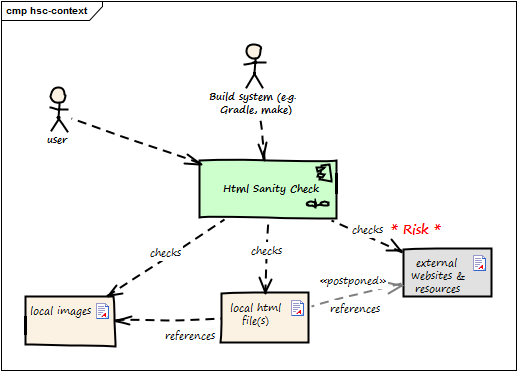
| Neighbor | Description |
|---|---|
user |
documents software with toolchain that generates html. Wants to ensure that links within this html are valid. |
build system |
|
local html files |
HtmlSC reads and parses local html files and performs sanity checks within those. |
local image files |
HtmlSC checks if linked images exist as (local) files. |
external web resources |
HtmlSC can be configured to optionally check for the existence of external web resources. Due to the nature of web systems, this check might need a significant amount of time and might yield invalid results due to network and latency issues. |
3.2. Deployment Context
The following diagram shows the participating computers ({node}) with their technical connections plus the major {artifact} of HtmlSC, the hsc-plugin-binary.
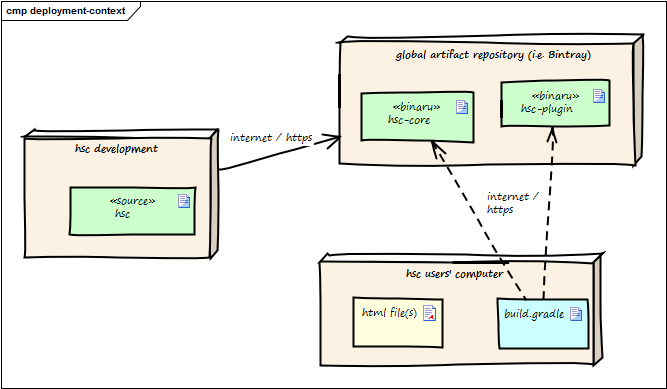
| Node / Artifact | Description |
|---|---|
{node} hsc-development |
where development of HtmlSC takes place |
{artifact} hsc-plugin-binary |
compiled and packaged version of HtmlSC including required dependencies. |
{node} artifact repository (Bintray) |
global public cloud repository for binary artifacts, similar to mavenCentral. HtmlSC binaries are uploaded to this server. |
{node} hsc user computer |
where arbitrary documentation takes place with html as output formats. |
{artifact} build.gradle |
Gradle build script configuring (among other things) the HtmlSC plugin to perform the Html checking. |
Details see deployment view.
4. Solution Strategy
-
Implement HtmlSC in Groovy and Java with minimal external dependencies. Wrap this implementation into a Gradle plugin, so it can be used within automated builds. Details are given in the Gradle plugin concept.
-
Apply the template-method-pattern (see e.g. {template-method-url}) to enable:
-
multiple checking algorithms. See the concept for checking algorithms,
-
both HTML (file) and text (console) output. See the reporting concept.
-
5. Building Block View
5.1. Whitebox HtmlSanityChecker

- Rationale
-
We used functional decomposition to separate responsibilities:
-
CheckerCore shall encapsulate checking logic and Html parsing/processing.
-
all kinds of outputs (console, html-file, graphical) shall be handled in a separate component (
Reporter) -
Implementation of Gradle specific stuff shall be encapsulated.
-
- Contained Blackboxes
hsc core: html parsing and sanity checking, configuration, reporting. |
|
HSC Gradle Plugin |
integrates the Gradle build tool with HtmlSC, enabling arbitrary gradle builds to use HtmlSC functionality. |
HSC Maven Plugin |
(planned, not yet implemented) |
HSC Graphical Interface |
(planned, not implemented) |
- Interfaces
| Interface | Description |
|---|---|
usage via shell |
arc42 user uses a command line shell to call the HtmlSC |
build system |
currently restricted to Gradle: The build system uses HtmlSC as configured in the buildscript. |
local-file system |
HtmlSC needs access to several local files, especially the html page to be checked and to the corresponding image directories. |
external websites |
to check external links, HtmlSC needs to access external sites via http HEAD or GET requests. |
5.1.1. HSC Core (Blackbox)
- Intent/Responsibility
-
HSC_Core contains the core functions to perform the various sanity checks. It parses the html file into a DOM-like in-memory representation, which is then used to perform the actual checks.
- Interfaces
| Interface (From-To) | Description |
|---|---|
Command Line Interface → Checker |
Uses the #AllChecksRunner class. |
Gradle Plugin → Checker |
Exposes HtmlSC via a standard Gradle plugin, as described in the Gradle user guide. |
- Files
-
-
org.aim42.htmlsanitycheck.AllChecksRunner
-
org.aim42.htmlsanitycheck.HtmlSanityCheckGradlePlugin
-
5.2. Building Blocks - Level 2
5.2.1. HSC-Core (Whitebox)
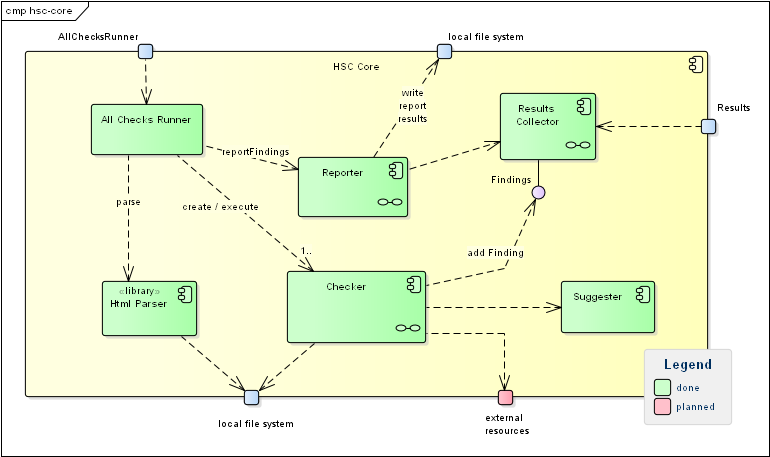
- Rationale
-
This structures follows a strictly functional decomposition:
-
parsing and handling html input
-
checking
-
collecting checking results
-
- Contained Blackboxes
Checker |
Abstract class, used in form of the template-pattern. Shall be subclassed for all checking algorithms. |
AllChecksRunner |
Facade to the different Checker instances. Provides a (parameter-driven) command-line interface. |
Collects all checking results. Its interface |
|
Reporter |
Reports checking results to either console or an html file. |
HtmlParser |
Encapsulates html parsing, provides methods to search within the (parsed) html. |
Suggester |
In case of checking issues, suggests alternatives by comparing the faulty element to the one present in the html file. Currently not implemented |
5.2.2. Checker and xyzChecker Subclasses
The abstract Checker provides a uniform interface (public void check())
to different checking algorithms. It is based upon the concept of extensible checking algorithms.
5.3. Building Blocks - Level 3
5.3.1. ResultsCollector (Whitebox)

- Rationale
-
This structures follows the hierarchy of checks - namely managing results for:
-
a number of pages/documents, containing:
-
a single page, each containing many
-
single checks within a page
-
- Contained Blackboxes
Per-Run Results |
results for potentially many Html pages/documents. |
Single-Page-Results |
results for a single page |
Single-Check-Results |
results for a single type of check (e.g. missing-images check) |
Finding |
a single finding, (e.g. "image 'logo.png' missing"). Can hold suggestions and (planned for future releases) the responsible html element. |
Interface Results
The Result interface is used by all clients
(especially Reporter subclasses, graphical and command-line
clients) to access checking results. It consists of three distinct APIs for
overall RunResults, single-page results (PageResults) and single-check results
(CheckResults). See the interface definitions below - taken from the Groovy-
source code:
public interface RunResults {
// returns results for all pages which have been checked
public ArrayList<SinglePageResults> getResultsForAllPages()
// how many pages were checked in this run?
public int nrOfPagesChecked()
// how many checks were performed in all?
public int nrOfChecksPerformedOnAllPages()
// how many findings (errors and issues) were found in all?
public int nrOfFindingsOnAllPages()
// how long took checking (in milliseconds)?
public Long checkingTookHowManyMillis()
}public interface PageResults {
// what's the title of this page?
public String getPageTitle()
// what's the filename and path?
public String getPageFileName()
public String getPageFilePath()
// how many items have been checked?
public int nrOfItemsCheckedOnPage()
// how many problems were found on this page?
public int nrOfFindingsOnPage()
// how many different checks have run on this page?
public int howManyCheckersHaveRun()
}public interface CheckResults {
// return a description of what is checked
// (e.g. "Missing Images Checker" or "Broken Cross-References Checker"
public String description()
// returns all findings/problems found during this check
public ArrayList<Finding> getFindings()
}7. Deployment View

| Node / Artifact | Description |
|---|---|
hsc plugin binary |
compiled version of HtmlSC, including required dependencies. |
hsc-development |
where development of HtmlSC takes place |
artifact repository (Bintray) |
global public cloud repository for binary artifacts, similar to mavenCentral. HtmlSC binaries are uploaded to this server. |
hsc user computer |
where arbitrary documentation takes place with html as output formats. |
build.gradle |
Gradle build script configuring (among other things) the HtmlSC plugin to check some documentation. |
The three nodes (computers) shown in Deployment are connected via Internet.
Sanity checker will:
-
be bundled as a single jar,
-
be uploaded to the Bintray repository,
-
referencable within a gradle buildfile,
-
provide a main method with parameters and options, so all checks can be called from the command line.
8. Technical and Crosscutting Concepts
8.1. HTML Checking Domain Model
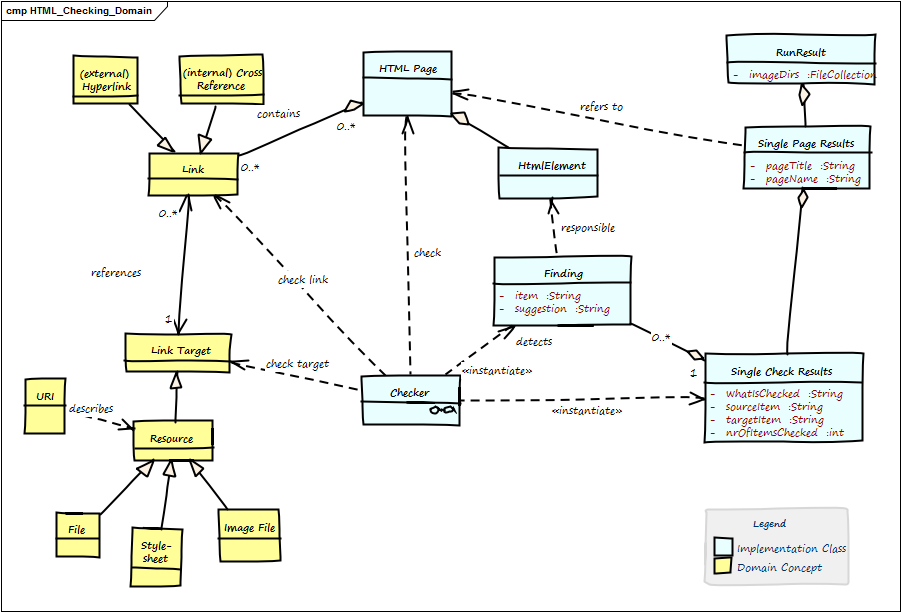
| Term | Description |
|---|---|
Anchor |
Html element to create →Links. Contains link-target in the form |
Cross Reference |
Link from one part of the document to another part within the same document. A special form of →Internal Link, with a →Link Target in the same document. |
External Link |
Link to another page or resource at another domain. |
Finding |
Description of a problem found by one →Checker within the →Html Page. |
Html Element |
HTML pages (documents) are made up by HTML elements .e.g., |
Html Page |
A single chunk of HTML, mostly regarded as a single file. Shall comply to standard HTML syntax. Minimal requirement: Our HTML parser can successfully parse this page. Contains →Html Elements. Also called Html Document. |
id |
Identifier for a specific part of a document, e.g. |
Internal Link |
Link to another section of the same page or to another page of the same domain. Also called Local Link. |
Link |
Any a reference in the →Html Page that lets you display or activate another part of this document (→Internal Link) or another document, image or resource (can be either →Internal (local) or →External Link). Every link leads from the Link Source to the Link Target |
Link Target |
The target of any →Link, e.g. heading or any other a part of a →Html Document, any internal or external resource (identified by URI). Expressed by →id |
Local Resource |
local file, either other Html files or other types (e.g. pdf, docx) |
Run Result |
The overall results of checking a number of pages (at least one page). |
Single Page Result |
A collection of all checks of a single →Html Page. |
URI |
Universal Resource Identifier. Defined in RFC-2396. The ultimate source of truth concerning link syntax and semantic. |
8.2. Gradle Plugin Concept and Development
You should definitely read the original Gradle User Guide on custom plugin development.
To enable the required Gradle integration, we implement a lean wrapper as described in the Gradle user guide.
class HtmlSanityCheckPlugin implements Plugin<Project> {
void apply(Project project) {
project.task('htmlSanityCheck',
type: HtmlSanityCheckTask,
group: 'Check')
}
}8.2.1. Directory Structure and Required Files
|-htmlSanityCheck | |-src | | |-main | | | |-org | | | | |-aim42 | | | | | |-htmlsanitycheck | | | | | | | ... | | | | | | |-HtmlSanityCheckPlugin.groovy (1) | | | | | | |-HtmlSanityCheckTask.groovy | | | |-resources | | | | |-META-INF (2) | | | | | |-gradle-plugins | | | | | | |-htmlSanityCheck.properties (3) | | |-test | | | |-org | | | | |-aim42 | | | | | |-htmlsanitycheck | | | | | | | ... | | | | | | |-HtmlSanityCheckPluginTest |
| 1 | the actual plugin code: HtmlSanityCheckPlugin.groovy and
HtmlSanityCheckTask.groovy groovy files |
| 2 | Gradle expects plugin properties in META-INF |
| 3 | property file containing the name of the actual implementation class:
implementation-class=org.aim42.htmlsanitycheck.HtmlSanityCheckPlugin |
8.2.5. Further Information on Creating Gradle Plugins
Although writing plugins is described in the Gradle user guide, a clearly explained sample is given in a Code4Reference tutorial.
8.3. Flexible Checking Algorithms
HtmlSC uses the template-method-pattern to enable flexible checking algorithms:
The Template Method defines a skeleton of an algorithm in an operation, and defers some steps to subclasses.
We achieve that by defining the skeleton of the checking algorithm in one operation, deferring the specific checking algorithm steps to subclasses.
The invariant steps are implemented in the abstract base class, while the variant checking algorithms have to be provided by the subclasses.
1
2
3
4
5
6
7
8
9
10
11
12
13
14
15
16
17
/**
** template method for performing a single type of checks on the given @see HtmlPage.
*
* Prerequisite: pageToCheck has been successfully parsed,
* prior to constructing this Checker instance.
**/
public SingleCheckResults performCheck( final HtmlPage pageToCheck) {
// assert non-null htmlPage
assert pageToCheck != null
checkingResults = new SingleCheckResults()
// description is set by subclasses
initCheckingResultsDescription()
return check( pageToCheck ) // <1> delegate check() to subclass
}
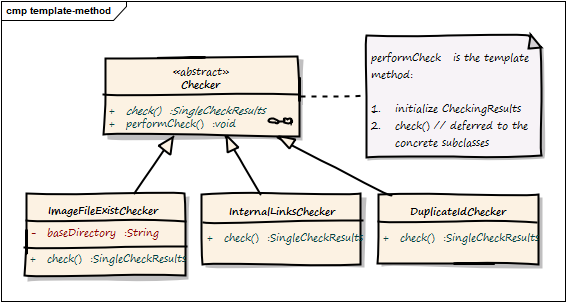
| Component | Description |
|---|---|
Checker |
abstract base class, containing the template method check() plus the public method performCheck() |
checks if referenced local image files exist |
|
checks if there are image tags without alt-attributes |
|
checks if cross references (links referenced within the page) exist |
|
checks if any id has multiple definitions |
|
checks if referenced other resources exist |
|
checks if external links are valid |
|
checks if links do not violate HTML link syntax |
8.3.1. MissingImageFilesChecker
Addresses requirement R-1.
Checks if image files referenced in <img src="someFile.jpg"> really exists on the local file system.
The (little) problem with checking images is their path: Consider the following HTML fragment (from the file testme.html):
<img src="./images/one-image.jpg">This image file ("one-image.jpg") has to be located relative to the directory containing the corresponding HTML file.
Therefore the expected absolute path of the "one-image.jpg" has to be determined from the absolute path of the html file under test.
We check for existing files using the usual Java API, but have to do some directory arithmetic to get the absolutePathToImageFile:
File f = new File( absolutePathToImageFile );
if(f.exists() && !f.isDirectory())8.3.2. MissingImgAltAttributeChecker
Addresses requirement R-6.
Simple syntactic check: iterates over all <img> tags to check if the image has an alt-tag.
8.3.3. BrokenCrossReferencesChecker
Addresses requirement R-2.
Cross references are document-internal links where the href="link-target" from the html anchor tag has no prefix like +http, https, ftp, telnet, mailto, file and such.
Only links with prefix # shall be taken into account, e.g. <a href="#internalLink">.
8.3.4. DuplicateIdChecker
Addresses requirement R-4.
Sections, especially headings, can be made link-targets by adding the id="#xyz" element, yielding for example html headings like the following example.
Problems occur if the same link target is defined several times (also shown below).
<h2 id="seealso">First Heading</h2>
<h2 id="seealso">Second Heading</h2>
<a href="#seealso">Duplicate definition - where shall I go now?</a>8.3.5. MissingLocalResourcesChecker
Addresses requirement R-3.
Current limitation: Does NOT check references-with-anchors of the following form:
<a href="api/core/Artifact.html#mvcGroupInit">GroupInit</a>containing both a local (file) reference plus an internal anchor #mvcGroupInit
8.3.6. BrokenHttpLinksChecker
Addresses requirement R-9.
Problem here are networking issues, latency and HTTP return codes. This checker is planned, but currently not implemented.
8.3.7. IllegalLinkChecker
Addresses requirement R-5.
This checker is planned, but currently not implemented.
8.4. Encapsulate HTML Parsing
We encapsulate the third-party HTML parser (http://jsoup.org) in simple wrapper classes with interfaces specific to our different checking algorithms.
8.5. Flexible Reporting
HtmlSC allows for different output formats:
-
formats (HTML and text) and
-
destinations (file and console)
The reporting subsystem uses the template method pattern to allow different output formats (e.g. Console and HTML). The overall structure of reports is always the same:
Graphical clients can use the API of the reporting subsystem to display reports in arbitrary formats.
The (generic and abstract) reporting is implemented in the abstract Reporter class as follows:
/**
* main entry point for reporting - to be called when a report is requested
* Uses template-method to delegate concrete implementations to subclasses
*/
public void reportFindings() {
initReport() (1)
reportOverallSummary() (2)
reportAllPages() (3)
closeReport() (4)
}
//
private void reportAllPages() {
pageResults.each { pageResult ->
reportPageSummary( pageResult ) (5)
pageResult.singleCheckResults.each { resultForOneCheck ->
reportSingleCheckSummary( resultForOneCheck ) (6)
reportSingleCheckDetails( resultForOneCheck ) (7)
reportPageFooter() (8)
}
}| 1 | initialize the report, e.g. create and open the file, copy css-, javascript and image files. |
| 2 | create the overall summary, with the overall success percentage and a list of all checked pages with their success rate. |
| 3 | iterate over all pages |
| 4 | write report footer - in HTML report also create back-to-top-link |
| 5 | for a single page, report the nr of checks and problems plus the success rate |
| 6 | for every singleCheck on that page, report a summary and |
| 7 | all detailed findings for a singleCheck. |
| 8 | for every checked page, create a footer, page break or similar to graphically distinguish pages between each other. |
8.5.1. Styling the Reporting Output
-
The
HtmlReporterexplicitly generates css classes together with the html elements, based upon css styling re-used from the Gradle JUnit plugin. -
Stylesheets, a minimized version of jQuery javascript library plus some icons are copied at report-generation time from the jar-file to the report output directory.
-
Styling the back-to-top arrow/button is done as a combination of JavaScript plus some css styling, as described in http://www.webtipblog.com/adding-scroll-top-button-website/.
8.5.2. Copy Required Resources to Output Directory
When creating the HTML report, we need to copy the required resource files (css, JavaScript) to the output directory.
The appropriate copy method was re-used from the Gradle sources.
8.5.3. Attributions
Credits for the arrow-icon https://www.iconfinder.com/icons/118743/arrow_up_icon
9. Design Decisions
9.1. Checking of external links postponed
In the current {revision} we won’t check external links. These checks have been postponed to later versions.
9.2. HTML Parsing with jsoup
To check HTML we parse it into an internal (DOM-like) representation. For this task we use jsoup HTML parser, an open-source parser without external dependencies.
To quote from the jsoup website:
jsoup is a Java library for working with real-world HTML. It provides a very convenient API for extracting and manipulating data, using the best of DOM, CSS, and jQuery-like methods.
- Goals of this decision
-
Check HTML programmatically by using an existing API that provides access and finder methods to the DOM-tree of the file(s) to be checked.
- Decision Criteria
-
-
few dependencies, so the HtmlSC binary stays as small as possible.
-
accessor and finder methods to find images, links and link-targets within the DOM tree.
-
- Alternatives
-
-
HTTPUnit: a testing framework for web applications and -sites. Its main focus is web testing and it suffers from a large number of dependencies.
-
jsoup: a plain HTML parser without any dependencies (!) and a rich API to access all HTML elements in DOM-like syntax.
-
Find details on how HtmlSC implements HTML parsing in the HTML encapsulation concept.
9.3. String Similarity Checking with Jaro-Winkler-Distance
The small java-string-similarity library (by Ralph Allen Rice) contains implementations of several similarity-calculation algorithms. As it is not available as public binary, we use the sources instead, primarily:
net.ricecode.similarity.JaroWinklerStrategyTest net.ricecode.similarity.JaroWinklerStrategy
| The actual implementation of the similarity comparison has been postponed to a later release of HtmlSC |
10. Glossary
See the domain model for explanations of important terms.





